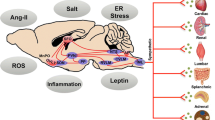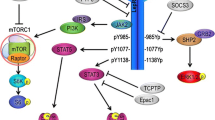Abstract
The sympathetic nervous system is activated in human obesity and in the analogous experimental obesity produced by overfeeding. The causes remain uncertain and may be multiple. The consequences include hypertension, probably attributable to activation of the sympathetic outflow to the kidneys, and, more disputed, insulin resistance. The pattern of sympathetic activation in normal-weight and obesity-related hypertension differs in terms of the firing characteristics of individual sympathetic fibers (increased rate of nerve firing in normal-weight hypertensives, increased number of active fibers firing at a normal rate in obesity-hypertension) and the sympathetic outflows involved. The underlying mechanisms and the adverse consequences of the two modes of sympathetic activation may differ. Should antihypertensive drug therapy in obesity-hypertension specifically target the existing neural pathophysiology? Such an approach can be advocated on theoretical grounds. Perhaps more important is the requirement that chosen antihypertensives do not cause weight gain or insulin resistance.
Similar content being viewed by others
References and Recommended Reading
Landsberg L, Young JB: Fasting, feeding and regulation of the sympathetic nervous system. N Engl J Med 1978, 298:1295–1301.
Jung RT, Shetty PS, James WPT: The effect of beta-adrenergic blockade on resting metabolic rate and peripheral thyroid metabolism in obesity. Eur J Clin Invest 1980, 10:179–182.
Bielinski R, Schutz Y, Jequier E: Energy metabolism during postexercise recovery in man. Am J Clin Nutr 1985, 42:69–82.
Schwartz RS, Jaeger LF, Veith RC: Effect of clonidine on the thermic effect of feeding in humans. Am J Physiol 1988, 254:R90–R94.
Bray GA, York DA, Fisler JS: Experimental obesity: a homeostatic failure due to defective nutrient stimulation of the sympathetic nervous system. Vitam Horm 1989, 45:1–125.
Young JB, MacDonald IA: Sympathoadrenal activity in human obesity: heterogeneity of findings since 1980. Int J Obes Relat Metab Disord 1992, 16:959–967.
Rocchini AP, Moorhead C, DeRemer S, Bondie D: Pathogenesis of weight-related changes in blood pressure in dogs. Hypertension 1989, 13:922–928.
Kassab S, Kato T, Wilkins FC, et al.: Renal denervation attenuates the sodium retention and hypertension associated with obesity. Hypertension 1995, 25:893–897.
Antic V, Dulloo A, Montani JP: Short-term (5-day) changes in food intake alter daily hemodynamics in rabbits. Am J Hypertens 2003, 16:302–306.
Landsberg L: Diet, obesity and hypertension: a hypothesis involving insulin, the sympathetic nervous system, and adaptive thermogenesis. Q J Med 1986, 236:1081–1090.
von Euler US: A specific sympathetic ergone in adrenergic nerve fibres (sympathin) and its relation to adrenaline and noradrenaline. Acta Physiol Scand 1946, 12:73–97.
Esler M, Jennings G, Lambert G, et al.: Overflow of catecholamine neurotransmitters to the circulation: source, fate and functions. Physiol Rev 1990, 70:963–985.
Grassi G, Colombo M, Seravalle G, et al.: Dissociation between muscle and skin sympathetic nerve activity in essential hypertension, obesity, and congestive heart failure. Hypertension 1998, 31:64–67.
Macefield V, Wallin BG, Vallbo AB: The discharge behaviour of single vasoconstrictor motor neurones in human muscle nerves. J Physiol 1994, 481:799–809.
Esler M, Jennings G, Korner P, et al.: The assessment of human sympathetic nervous system activity from measurements of norepinephrine turnover. Hypertension 1988, 11:3–20.
Rumantir MS, Vaz M, Jennings GL, et al.: Neural mechanisms in human obesity-related hypertension. J Hypertens 1999, 17:1125–1133.
Esler M: Looking at the sympathetic nervous system as a primary source. In Handbook of Hypertension: Hypertension Research in the Twentieth Century. Edited by Zanchetti A, Robertson JIS, Bikenhager WH. Amsterdam: Elsevier; 2004: 81–103.
Greenwood JP, Stoker JB, Mary DASG: Single-unit sympathetic discharge. Quantitative assessment in human hypertensive disease. Circulation 1999, 100:1305–1310.
Lambert E, Straznicky N, Schlaich M, et al.: Differing patterns of sympathoexcitation in normal-weight and obesity-related hypertension. Hypertension 2007, 50:862–868.
DiBona GF: Sympathetic neural control of the kidney in hypertension. Hypertension 1992, 19:I28–I35.
Messerli FH, Sundgaard-Riise K, Reisin E, et al.: Disparate cardiovascular effects of obesity and arterial hypertension. Am J Med 1983, 74:808–812.
Sjostrom L: Morbidity and mortality of severely obese subjects. Am J Clin Nutr 1992, 55:508S–515S.
Hall JE, Brands MW, Hildebrandt DA, Mizelle HL: Obesity-associated hypertension. Hyperinsulinemia and renal mechanisms. Hypertension 1992, 19:I45–I55.
Julius S, Valentini M, Palatini P: Overweight and hypertension. A 2-way street? Hypertension 2000, 36:807–813.
Masuo K, Kawaguchi H, Mikami H: Serum uric acid and plasma norepinephrine concentrations predict subsequent weight gain and blood pressure elevation. Hypertension 2003, 42:474–480.
Ferrier C, Jennings GL, Eisenhofer G, et al.: Evidence for increased noradrenaline release from subcortical brain regions in essential hypertension. J Hypertens 1993, 11:1217–1227.
Esler M, Eikelis N, Schlaich M, et al.: Chronic mental stress is a cause of essential hypertension: presence of biological markers of stress. Clin Exp Pharm Physiol 2008, 35:498–502.
Esler M, Lambert G, Vaz M, et al.: Central nervous system monoamine neurotransmitter turnover in primary and obesity-related human hypertension. Clin Exp Hypertens 1997, 19:577–590.
Haynes WG, Sivitz WI, Morgan DA, et al.: Sympathetic and cardiorenal actions of leptin. Hypertension 1997, 30:619–623.
Narkiewicz K, Van de Borne PJH, Cooley RL, et al.: Sympathetic activity in obese subjects with and without obstructive sleep apnoea. Circulation 1998, 98:772–776.
Grassi G, Facchini A, Trevano FQ, et al.: Obstructive sleep apnea-dependent and -independent adrenergic activation in obesity. Hypertension 2005, 46:321–325.
Masuo K, Katsuya T, Fu Y, et al.: Beta2- and beta3-adrenergic receptor polymorphisms are related to the onset of weight gain and blood pressure elevation over 5 years. Circulation 2005, 111:3429–3434.
Green SA, Cole G, Jacinto M, et al.: A polymorphism of the human beta 2-adrenergic receptor within the fourth transmembrane domain alters ligand binding and functional properties of the receptor. J Biol Chem 1993, 268:23116–23121.
Schlaich MP, Kaye DM, Lambert E, et al.: Relation between cardiac sympathetic activity and hypertensive left ventricular hypertrophy. Circulation 2003, 108:560–565.
Julius S, Gundrandsson T, Jamerson K, et al.: The interconnection between sympathetics, microcirculation and insulin resistance in hypertension. Blood Press 1992, 1:9–19.
Esler M, Straznicky N, Eikelis N, et al.: Mechanisms of sympathetic activation in obesity-related hypertension. Hypertension 2006, 48:787–796.
Haenni A, Lithell H: Moxonidine improves insulin sensitivity in insulin-resistant hypertensives. J Hypertens 1999, 19:S29–S35.
Bell-Anderson KS, Bryson JM: Leptin as a potential treatment for obesity: progress to date. Treat Endocrinol 2004, 3:11–18.
O’Dea K, Esler M, Leonard P, et al.: Noradrenaline turnover during under- and over-eating in normal weight subjects. Metabolism 1982, 31:896–899.
Laaksonen DE, Laitinen T, Schonberg J, et al.: Weight loss and weight maintenance, ambulatory blood pressure and cardiac autonomic tone in obese persons with the metabolic syndrome. J Hypertens 2003, 21:371–378.
Esler M: On a low calorie diet, are there separate and discrete effects of negative energy balance and weight loss on blood pressure? J Hypertens 2003, 21:261–262.
Dickinson HO, Mason JM, Nicolson DJ, et al.: Lifestyle interventions to reduce raised blood pressure: a systematic review of randomized controlled trials. J Hypertens 2006, 24:215–233.
Meredith IT, Friberg P, Jennings GL, et al.: Regular exercise lowers renal but not cardiac sympathetic activity in man. Hypertension 1991, 18:575–582.
Hasking G, Esler M, Jennings G, et al.: Norepinephrine spillover to plasma in congestive heart failure: evidence of increased overall and cardiorenal sympathetic nervous activity. Circulation 1986, 73:615–621.
Kaye DM, Lefkovits J, Jennings GL, et al.: Adverse consequences of high sympathetic nervous activity in the failing human heart. J Am Coll Cardiol 1995, 26:1257–1263.
Packer M, Bristow MR, Cohn JN, et al.: The effects of carvedilol on morbidity and mortality in patients with chronic heart failure. U.S. Carvedilol Heart Failure Study Group. N Engl J Med 1996, 334:1349–1355.
Sharma AM, Wagner T, Marsalek P: Moxonidine in the treatment of overweight and obese patients with the metabolic syndrome: a postmarketing surveillance study. J Hum Hypertens 2004, 18:669–675.
Wofford MR, Anderson DC, Brown CA, et al.: Antihypertensive effect of alpha- and beta-adrenergic blockade in obese and lean hypertensive subjects. Am J Hypertens 2002, 14:694–698.
Grassi G, Servalle G, Dell’Oro R, et al.: Comparative effects of candesartan and hydrochlorothiazide on blood pressure, insulin sensitivity, and sympathetic drive in obese hypertensive individuals: results of the CROSS study. J Hypertens 2003, 21:1761–1769.
Reisin E, Weir MR, Falkner B, et al.: Lisinopril versus hydrochlorothiazide in obese hypertensive patients. Hypertension 1997, 30:140–145.
Author information
Authors and Affiliations
Corresponding author
Rights and permissions
About this article
Cite this article
Esler, M.D., Eikelis, N., Lambert, E. et al. Neural mechanisms and management of obesity-related hypertension. Curr Cardiol Rep 10, 456–463 (2008). https://doi.org/10.1007/s11886-008-0072-7
Published:
Issue Date:
DOI: https://doi.org/10.1007/s11886-008-0072-7




